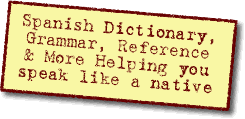Ask a Question(Create a thread) |
|
|||||||
Imperative or presentGrammar questions– conjugations, verb tenses, adverbs, adjectives, word order, syntax, etc. |
 |
|
|
Thread Tools |
|
Get rid of these ads by registering for a free Tomísimo account.
|
|
#2
|
||||
|
||||
|
Just like in English, the imperative is used without saying 'you'.
So, the one where you used a subject pronoun is a statement, instead of an imperative. By the way, in Spanish, the subject pronoun can be placed in front of the verb, after the verb, or at the end, and is only needed for clarification in the third person as to who the subject is. The third example could be either an imperative or a statement. Context is the key. The exclamation is an imperative. |
|
#4
|
||||
|
||||
|
Toma (tú) este camino y gira (tú) a la derecha
Tome (usted) este camino y gire (usted) a la derecha Both imperatives (the second sentence, subjunctive in the role of imperative) But now (Tú) Tomas este camino y (tú) giras a la derecha (Usted) Toma este camino y (usted) gira a la derecha present indicative. The mistake was mixing up toma (imperative, second person) with toma (present indicative, third person, in the example used as a courteous second person)
__________________
Sorry, no English spell-checker |
 |
«
Previous Thread
|
Next Thread
»
| Link to this thread | |
|
|
|||||||
 Similar Threads
Similar Threads
|
||||
| Thread | Thread Starter | Forum | Replies | Last Post |
| Present Progressive Vs Present Indicative | Donquick | Grammar | 2 | October 02, 2014 11:45 AM |
| Present Progressive form using estar + present participle | Joystar1977 | Practice & Homework | 2 | November 18, 2013 01:57 PM |
| Present continous vs simple present | ROBINDESBOIS | Grammar | 2 | October 23, 2013 11:21 AM |
| Present vs. Present Progressive Use in Every Day Speaking | Awaken | Grammar | 8 | July 09, 2010 11:49 AM |
All times are GMT -6. The time now is 05:15 PM.






